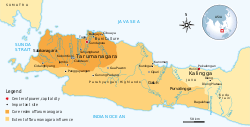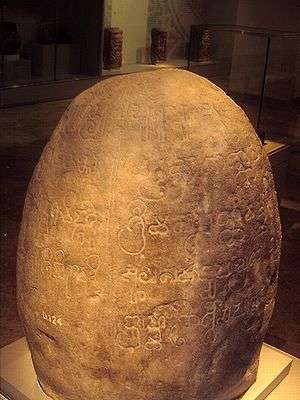Tarumanagara
| Tarumanagara | ||||||||||||||
| ||||||||||||||
 The territory of Tarumanagara | ||||||||||||||
| Capital | Sundapura (near Tugu, Jakarta and Bekasi) | |||||||||||||
| Languages | Sundanese, Sanskrit | |||||||||||||
| Religion | Hinduism, Buddhism, Animism, Sunda Wiwitan | |||||||||||||
| Government | Monarchy | |||||||||||||
| History | ||||||||||||||
| • | Established | 358 | ||||||||||||
| • | Sriwijaya invasion in 650 | 669 | ||||||||||||
| ||||||||||||||
Tarumanagara or Taruma Kingdom or just Taruma is an early Sundanese Indianised kingdom, whose 5th-century ruler, Purnawarman, produced the earliest known inscriptions on Java island. The kingdom was located not far from modern Jakarta, and according to Tugu inscription Purnavarman apparently built a canal that changed the course of the Cakung River, and drained a coastal area for agriculture and settlement. In his inscriptions, Purnavarman associated himself with Vishnu, and Brahmins ritually secured the hydraulic project.[1] Tarumanagara is believed was existed between 358–669 CE in Western Java region, in and around modern day Bogor, Bekasi and Jakarta, roughly corresponds to modern Greater Jakarta area.
The earliest known written records of Tarumanagara existence were inscribed in stone inscriptions.[2] Inscribed stone is called prasasti in Indonesian. Numbers of stone inscriptions dated from Tarumanagara period was discovered in Western Java region.
Historiography
In 1863, Dutch East Indies, a huge boulder of inscribed stone was spotted near Ciampea not far from Buitenzorg (Bogor). The stone inscription was discovered on the river bed of Ciaruteun river, a tributary of Cisadane River. It is today known as Ciaruteun inscription, dated from the 5th century, written in Vengi letters (used in the Indian Pallava period) and in Sanskrit language. This is the earliest inscription that clearly mentioned the kingdom's name "Tarumanagara".[3]:15 The inscription reports the most famous king of Tarumanagara.
"The powerful illustrious and brave King, the famous Purnawarman (of the) Tarumanagara (kingdom) whose (print of the) foot soles are the same (as those of) God Vishnu."
Ciaruteun inscription.[3]:15
Located nearby is the Prasasti Kebon Kopi I, also called Telapak Gadjah stone, with an inscription and the engraving of two large elephant footprints. The inscription read: These elephant foot soles, akin to those of the strong Airwata (elephant, which God Indra used to ride), belongs to Tarumanagara King who is successful and full of control.
Not only stones testify of the existence of King Purnawarman and his Tarumanagara kingdom. There are also Chinese historical sources, since Tarumanagara maintained extended trade and diplomatic relations in the territory stretching between India and China. The Chinese Buddhist Monk Fa Xian reported in his book fo-kuo-chi (414) that he stayed on the island of Ye-po-ti (Chinese spelling of Javadvipa), most probably the western part of Java island, for six months, from December 412 until May 413. He reported that the Law of Buddha was not much known, but that the Brahmans (Hinduism) flourished, and heretics (animists) too.
Between the period 528 to 669, Tarumanagara sent their embassy to Chinese court.[4]:105 The kingdom was mentioned in the annals of the Sui dynasty, the king of To-lo-mo (Taruma) has sent diplomatic mission, which arrived in China in 528 and 535. It was mentioned that the kingdom is located far south of China.
The annals of Tang dynasty also mentioned in the year 666 and 669 the envoys of To-lo-ma has visited the court of Tang.[5]:54
Etymology
The name Tarumanagara was found in several inscriptions in the Western Java region dated from circa 4th century. The Chinese chronicle also recorded the name To-lo-ma or To-lo-mo which suggest the Chinese pronunciation of "Taruma". Tarumanagara means the kingdom of Taruma. The name "Taruma" itself is connected to the Citarum River of West Java. In Sundanese language, ci means water or river while tarum means indigo plant. Tarum is local name of indigo plant that used to create the indigo dyeing pigment.[6]
First rulers

According to the book Nusantara, Maharshi Rajadirajaguru Jayasingawarman founded the Tarumanagara kingdom in 358. Jayasingawarman originated from Salankayana, India that collapsed after the invasion of Samudragupta from Gupta Empire. After re-settling in Western Java, he married a Sundanese princess daughter of King Dewawarman VIII of Salakanagara.[7] He died in 382 and was buried at the bank of Kali Gomati river (present-day Bekasi city). His son, Dharmayawarman ruled from 382 to 395. His burial site is at Chandrabaga river. His grandson Purnawarman was the third king of Tarumanagara and reigned from 395 to 434.
Age of Purnawarman
Book Nusantara, parwa II sarga 3 (page 159 – 162) notes that under the reign of King Purnawarman, Tarumanagara held control over 48 small kingdoms with area stretching from Salakanagara or Rajatapura to Purwalingga (current city of Purbalingga in Central Java Province). Traditionally Cipamali river (Brebes river) was the border between Sunda and Java.
In 397, King Purnawarman established a new capital city for the kingdom, located near to a beach, called Sunda Pura meaning Holy Town or Pure Town. Thus, word “Sunda” was introduced for the first time by King Purnawarman in 397. Sunda Pura could have been near present-day Kampung Tugu (North Jakarta), or near present-day Bekasi. He left seven memorial stones with inscriptions bearing his name spread across current Banten and West Java provinces. The prasasti tugu, which is a few years older than the Parasasti Ciaruteun, is considered the oldest of all the inscriptions.
There are more stones with inscriptions from the time of king Purnawarman, some close to Bogor city. They are Prasasti Muara Cianten, Prasasti Pasir Awi, Prasasti Cidanghiang, and Parasasti Jambu. Prasasti Cidanghiang (sits further to the west at Lebak in the Pandeglang area), consisting of two lines, proclaiming Purnawarman as the standard for rulers around the world. Prasasti Jambu, with a two-line inscription in Pallava/Sanskrit, bears the large footprints of the king. The inscription translates as:
The name of the king who is famous of faithfully executing his duties and who is incomparable (peerless) is Sri Purnawarman who reigns Taruma. His armour cannot be penetrated by the arrows of his enemies. The prints of the foot soles belong to him who was always successful to destroy the fortresses of his enemies, and was always charitable and gave honorable receptions to those who are loyal to him and hostile to his enemies.
Kings after Purnawarman
Purnawarman probably is the most well-known king of Tarumanagara because he produced quite a numbers of well documented inscriptions. The records about Tarumanagara's later kings were scarce and obscure, most were known from later manuscripts and local traditions.
Later series of Tarumanagara kings are only known from their names, all bears the name warman (Sanskrit: varman means "shield" or "protector") which suggests that all of them belongs in the same dynasty.
A rather detailed information was known about King Suryawarman that ruled from 535 to 561. King Suryawarman established a new capital city eastward and left Sundapura and its communities to preserve their own order. Then, Sundapura become a new smaller kingdom called Sunda Sambawa which was under control of Tarumanagara. Before the Suryavarman reigned Tarumanagara, Manikmaya, his son in-law, in 526, left Sundapura went southeastward and established Kendan, a new kingdom currently in Nagreg area, near modern Garut city.
Kertawarman ruled c. 561 to 628. During this period the grandson of Manikmaya, Wretikandayun, in 612, established Galuh Kingdom, southeast of current Garut with its capital city located in Banjar Pataruman. Kertawarman's successor, King Linggawarman ruled from 628 to 650, he however produced no male heir. Linggawarman's eldest daughter Manasih, married to Tarusbawa, ruler of Sunda Sembawa. While the second daughter of King Linggawarman, Princess Sobakancana, married Dapunta Hyang Sri Jayanasa, who later established the Srivijaya kingdom.
Decline
King Tarusbawa of Sunda Sembawa (Tarumanagara's vassal) married to Manasih, the eldest daughter of Linggawarman, thus made him the successor of Linggawarman. Tarusbawa however was more interested to reestablish his own home kingdom Sundapura, as his new capital and abandoning Tarumanagara's capital.
This event was made as a reason by king Wretikandayun (monarchic founder of Galuh) to dissociate Galuh from Tarumanagara. He demanded King Tarusbawa to divide Tarumanagara territory into two parts. Galuh got a support from Kalingga kingdom (the first kingdom in Central Java) to separate from Tarumanagara because Galuh and Kalingga had made an alliance through dynastic marriage; a son of King Wretikandayun married Parwati (a daughter of Queen Shima) from Kalingga and Sana alias Bratasenawa alias Sena (a grandson of King Wretikandayun) married Sanaha (a granddaughter of Queen Sima). In a weak position and wishing to avoid civil war, the young King Tarusbawa accepted the request of old King Wretikandayun.
After 670, Tarumanagara was divided into two kingdoms: Sunda Kingdom and Galuh Kingdom with the Citarum river as the boundary. Then Galuh Kingdom comprised many vassal kingdoms which covered areas of present-day West and present-day Central Java Provinces.
According to 7th century Kota Kapur inscription, Srivijaya, centred in today Palembang, South Sumatra, launched a military expedition against Bhumi Jawa, the period coincides with the decline of Tarumanagara. It is very likely that Tarumanagara kingdom was attacked and defeated by Srivijaya around 686.[5]:83 The pretext behind Srivijayan campaign against Tarumanagara was obscure, however it was probably because of Jayanasa's own claim to Tarumanagara's throne, afterall his wife, Sobakancana, is the daughter of Linggawarman, the late king of Tarumanagara. After this naval invasion, Tarumanegara's influence began to decline.
Devastated by Srivijayan invasion, King Tarusbawa then moved further inland to find a refuge in the south and established a new capital near the Cipakancilan river upstream (today in modern Bogor). It seems that he left the coastal areas of port of Sunda and Kalapa (today coastal areas of modern Banten and Jakarta) under Srivijayan mandala's control. This capital centuries later became the city of Pakuan Pajajaran (or shortly called Pakuan or Pajajaran). King Tarusbawa becomes the predecessor of Sunda kings.
List of rulers
- Jayasingawarman, 358 - 382
- Dharmayawarman, 382 to 395. His burial site is at Chandrabaga river.
- Purnawarman, 395 - 434. Produced large numbers of inscriptions
- Wisnuwarman, 434 - 455
- Indrawarman, 455 - 515
- Candrawarman, 515 - 535
- Suryawarman, 535 - 561. Established new capital, left old capital of Sundapura, a new settlement was established inland in Kendan near modern Garut
- Kertawarman, 561 - 628. Establishment of Tarumanagara's colony Galuh Kingdom in 612 by Wretikandayun, the grandson of Manikmaya.
- Linggawarman, 628 - 650. Marriage arrangement with Dapunta Hyang Sri Jayanasa of Srivijaya and the second daughter of King Linggawarman, Princess Sobakancana.
- Tarusbawa, c. 670 - 690. Disintegration of Tarumanagara into Sunda Kingdom and Galuh Kingdom and independence of Galuh. Srivijayan invasion according to Kota Kapur inscription.
See also
References
- ↑ Mary Somers Heidhues (2000). Southeast Asia: A Concise History. London: Thames and Hudson. p. 45 and 63..
- ↑ Bogor City: Bogor Inscription
- 1 2 Zahorka, Herwig (2007). The Sunda Kingdoms of West Java, From Tarumanagara to Pakuan Pajajaran with the Royal Center of Bogor. Jakarta: Yayasan Cipta Loka Caraka.
- ↑ Munoz, Paul Michel (2006). Early Kingdoms of the Indonesian Archipelago and the Malay Peninsula. National Book Network. ISBN 9789814155670.
- 1 2 Coedès, George (1968). Walter F. Vella, ed. The Indianized States of Southeast Asia. trans.Susan Brown Cowing. University of Hawaii Press. ISBN 978-0-8248-0368-1.
- ↑ "Citarum dalam Perspektif Sejarah" (in Indonesian). National Geographic Indonesia.
- ↑ Garis Waktu Sejarah Nusantara
Bibliography
- Book Nusantara, Chapter II, Sub-chapter 3 (page 159 – 162)
- Edi S. Ekadjati, Kebudayaan Sunda Zaman Pajajaran, Jilid 2, Pustaka Jaya, 2005
- (1915, “Maharadja Cri Djajabhoepathi, Soenda’s Oudst Bekende Vorst”, TBG, 57. Batavia: BGKW, page 201-219)
Coordinates: 0°15′46″S 6°34′08″E / 0.262778°S 6.56889°E


